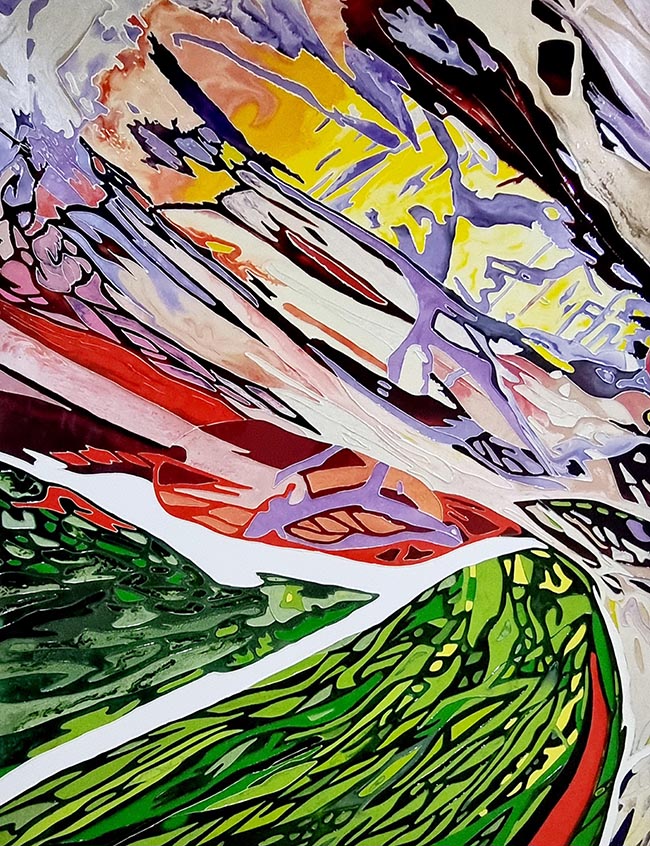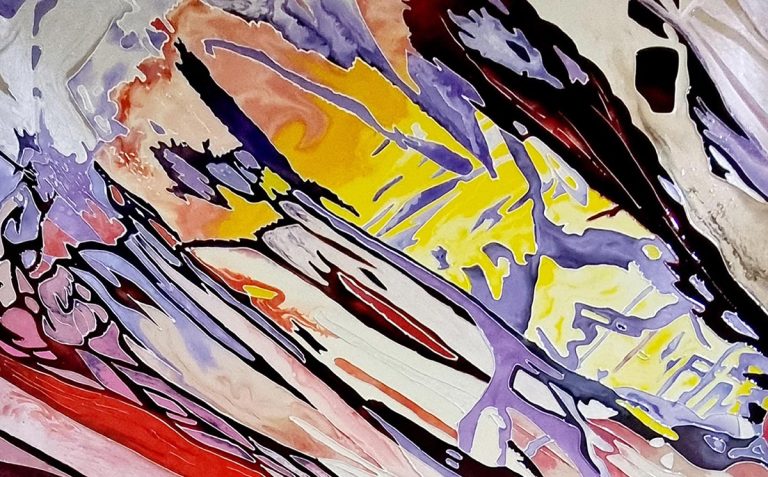Sabrina Puppin doesn’t just paint—she throws you into a storm of color and emotion. Based around the world and showing her work internationally, Puppin has carved out a space for herself where abstraction meets feeling. Her style is bold and unmistakable. You won’t find delicate strokes or minimal gestures. Instead, her canvases are packed with high-energy color, layered textures, and motion that seems to leap from the surface. These aren’t just paintings to look at—they’re paintings to experience.
What Puppin aims to do is more emotional than literal. Her works don’t try to mimic the world. They reshape it through her personal lens—through daydreams, feelings, and how perception warps over time. She gives us a visual diary, but it’s not about being told what to see. Her work is more like an open invitation: walk into the chaos, feel what you feel, and take your own meaning from it.

GALE (2025) is a force. It hits you first with color—warm oranges and reds swirl through the frame, giving the feeling of fire moving just beneath the surface. But it’s not wild for the sake of it. Cooler tones like pale blue and soft grey show up just when things get too hot, like a breath in the middle of shouting. The painting balances energy with pause.
The textures matter, too. There are thick layers and raised areas that pull the eye into the surface. You can almost see the brush dragging through, pushing and pulling the paint into place. There’s something controlled in all that wildness. Puppin’s color transitions feel like they were chosen in the moment but then thought through after—the kind of push-and-pull that comes from trusting instinct but refining craft. The result is a kind of visual wind. You don’t just see motion—you feel it on your skin.

STORM 3 (2023) doesn’t just live up to its name—it grabs you and throws you into it. The colors here don’t wait to be noticed. Bright purples, yellows, reds, and greens spin through the composition like they’re in a dance, each trying to take center stage. There’s a wild, celebratory quality to the way they’re placed. No one color dominates for too long, and the whole thing feels like it’s in constant flux.
Puppin uses big, sweeping gestures here. It’s easy to imagine her standing far back, arm stretched out, pulling the brush across the canvas in one fluid motion. These aren’t careful, small marks. They’re gestures of movement and energy. But despite the boldness, the painting doesn’t fall apart. It holds. Each shape and line seems to respond to the one before it. There’s rhythm to the chaos. It’s loud, but it works.

WAITING (2023) is calmer, but only on the surface. Look longer and you’ll find that same tension Puppin loves to play with. The blues, yellows, and whites move across the canvas in long, fluid lines—some thin, some thick, like streams of thought overlapping. There’s a sense of pacing here, of something about to happen but not quite yet. The title makes sense: there’s motion, but it’s holding itself back.
Inside all that movement, Puppin adds geometry. Small shapes and patterns appear within the brushstrokes—grids, diamonds, forms that feel deliberate. These details break up the flow and give your eyes places to rest. That contrast—between the freeform energy of the lines and the sharp order of the patterns—is where the painting comes to life. She’s not choosing chaos over calm or vice versa. She’s showing you how the two can live together, and maybe even rely on each other.
Across all three works, Puppin’s goal seems clear: give you something to feel, not just something to see. Her paintings aren’t narratives. They don’t walk you from beginning to end. Instead, they pulse with the energy of the moment—the kind of moments we all have but rarely try to put into words. Her abstract style isn’t a puzzle to solve. It’s an open field to move through.
And maybe that’s the point. Sabrina Puppin doesn’t want to define your experience. She wants to create a space where you get to choose your own way through. In that sense, her paintings don’t just reflect perception—they challenge it. They ask: what are you really seeing? And more importantly: how does it make you feel?

